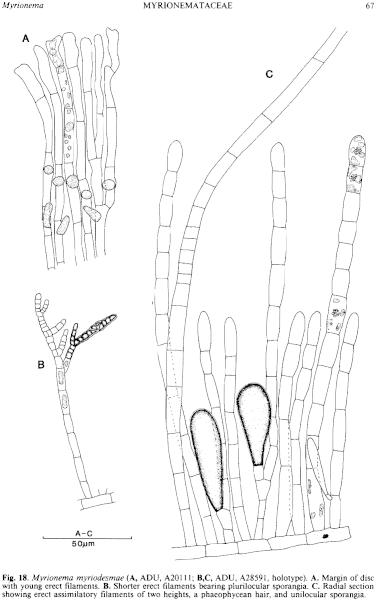|
|
|
|
|
|||||||||||
|
Electronic Flora of South Australia Species Fact Sheet
Phylum Phaeophyta – Order Chordariales – Family Myrionemataceae
Thallus dark brown, forming irregular, spreading, patches (0.5–) 2–7 mm across with the basal layer largely hidden by the flaccid erect filaments and long hairs, epiphytic on Myriodesma calophyllum. Basal layer (Fig. 18A) of closely adjacent, radiating filaments adherent to the host surface with small spinous outgrowths between the epidermal cells of the host; cells 10–25 µm long, 10–15 µm broad and 7–10 µm high, each with several phaeoplasts. Erect assimilatory filaments (Fig. 18C) of two heights, forming strata of intermixed filaments, at first with one filament per basal layer cell but later two, often long and short, from each cell; long filaments cylindrical, flaccid, (150–) 250–350 µm and 9–15 cells long, with cells 9–12 (–15) µm in diameter and L/B 2–4 below and L/B 1–2 above, each with several discoid phaeoplasts with a pyrenoid, and physodes; shorter filaments 80–120 µm and 4–5 cells long, of similar diameter to longer filaments. Hairs phaeophycean, with 5–11 elongate basal cells before the meristem (corresponding to half way up the long assimilatory filaments), then long-celled, becoming 1–1.2 mm long and 8–11 µm in diameter.
Reproduction: Plurilocular sporangia (Fig. I8B) borne laterally on erect assimilatory filaments, simple or once branched, uniseriate or occasionally biseriate with 10–14 locules each L/B 0.5–1(4.5), 30–40 µm long and 3–4 µm in diameter. Unilocular sporangia (Fig. 18C) borne singly or occasionally in pairs from the basal cell of erect filaments, ovoid-clavate, 40–60 µm long and 16–20 µ in diameter.
Type from Seal Beach, Kangaroo I., S. Aust., on Myriodesma calophyllum, drift (Womersley, 21.i.1965); holotype in ADU, A28591.
Distribution: Only known from the type and from Flour Cask Bay, Kangaroo I., S. Aust., on M. calophyllum, drift (Womersley, 12.ii.1956; ADU, A20164), and Stanley Beach, south coast of Kangaroo I., S. Aust., on M. calophyllum, drift ( Womersley, 7.ii.1956; ADU, A20111 and 27.i.1957; ADU, A20817).
Taxonomic notes: Myrionema myriodesmae, named after its host, is a distinctive species, with long assimilatory filaments (comparable to those in M. siliquosum Sauvageau 1936, p. 179, fig. 14) but also with shorter assimilatory filaments forming a second stratum, with the latter frequently arising from the same basal cell as a longer filament. The hairs are also distinctive in that their meristematic region is many cells (6–12) above their base, usually corresponding to part way up the long assimilatory filaments.
References:
SAUVAGEAU, C. (1936). Second mémoire sur les algues Phéosporées de Villefranche-sur-Mer. Bull. Stn biol. Arcachon 33, 117–204.
The Marine Benthic Flora of Southern Australia Part II complete list of references.
Publication:
Womersley, H.B.S. (14 December, 1987)
The Marine Benthic Flora of Southern Australia
Part II
©Board of the Botanic Gardens and State Herbarium, Government of South Australia
Illustration in Womersley Part II, 1997: FIG. 18.

Figure 18 enlarge
Fig. 18. Myrionema myriodesmae (A, ADU, A20111; B,C, ADU, A28591, holotype). A. Margin of disc with young erect filaments. B. Shorter erect filaments bearing plurilocular sporangia. C. Radial section showing erect assimilatory filaments of two heights, a phaeophycean hair, and unilocular sporangia.

|
Email Contact: State Herbarium of South Australia |

|